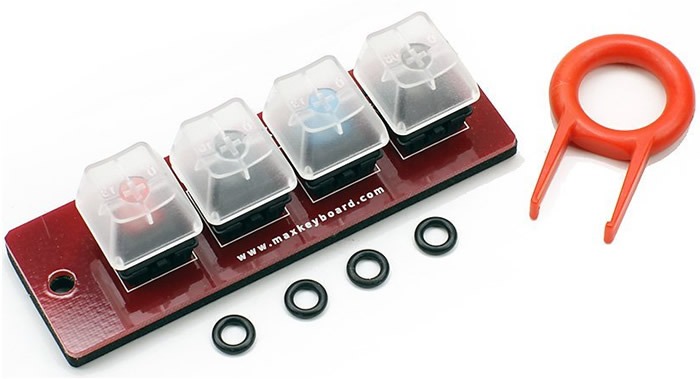When it comes to mechanical keyboards, one of the most important aspects to consider is the type of switch used.
The switch is the component that determines how a key feels and sounds when pressed. The three main types of mechanical keyboard switches are linear, tactile, and clicky.
Tactile VS Linear VS Clicky
In this head to head comparison, we’ll take a closer look at each type, their pros and cons, and help you decide which one is the best fit for your typing preferences.
Linear Switches
How Linear Switches Work
Linear switches are characterized by a smooth, consistent keystroke with no tactile feedback or audible click. The key travel is uniform from the moment the key is pressed until it bottoms out, providing a seamless typing experience. Examples of popular linear switches include Cherry MX Red, Gateron Red, and Kailh Red switches.
Pros and Cons of Linear Switches
Pros:
- Smooth keystroke with no tactile bump or click
- Ideal for fast typists and gamers who value speed and responsiveness
- Quieter than tactile and clicky switches
Cons:
- Lack of tactile feedback may lead to more typos or accidental key presses
- Can feel “boring” or “lifeless” for some users
Tactile Switches
How Tactile Switches Work
Tactile switches are designed to provide a tactile bump or feedback when the key is actuated, letting you know that the key has been successfully pressed. This tactile feedback helps to prevent accidental key presses and can improve typing accuracy. Examples of popular tactile switches include Cherry MX Brown, Gateron Brown, and Kailh Brown switches.
Pros and Cons of Tactile Switches
Pros:
- Tactile feedback can improve typing accuracy and reduce typos
- Suitable for both typing and gaming
- Offers a more engaging typing experience compared to linear switches
Cons:
- Slower key travel compared to linear switches
- Can be louder than linear switches, but quieter than clicky switches
Clicky Switches
How Clicky Switches Work
Clicky switches, as the name suggests, produce an audible click when the key is actuated. This is in addition to the tactile feedback experienced by the user. The combination of tactile feedback and audible click makes for a satisfying and engaging typing experience. Examples of popular clicky switches include Cherry MX Blue, Gateron Blue, and Kailh Blue switches.
Pros and Cons of Clicky Switches
Pros:
- Audible click and tactile feedback provide a satisfying typing experience
- Helps improve typing accuracy by providing clear feedback for each keypress
- Great for typists who enjoy a “mechanical” feel and sound
Cons:
- Louder than both linear and tactile switches, which can be bothersome to some users or in certain environments
- Slower key travel compared to linear switches
Comparing Linear, Tactile, and Clicky Switches
Key Travel and Actuation Force
Linear switches typically have the fastest key travel due to the lack of tactile bump or click. This makes them well-suited for situations where speed and responsiveness are crucial, such as gaming or fast typing. Tactile and clicky switches have a slightly slower key travel due to the tactile bump and audible click, respectively.
Actuation force, or the force required to press a key, can vary between switch types and even within the same type. Linear switches usually have a lighter actuation force, while tactile and clicky switches tend to require a bit more force to overcome the tactile bump or click.
Sound Profile
Linear switches are the quietest among the three types, making them a good choice for noise-sensitive environments. Tactile switches are louder than linear switches but still relatively quiet compared to clicky switches. Clicky switches produce the most noise due to the audible click, which can be a deal-breaker for some users or in certain settings.
Typing Experience
Ultimately, the choice between linear, tactile, and clicky switches boils down to personal preference and the desired typing experience. Linear switches offer a smooth, fast typing experience, tactile switches provide feedback for improved accuracy, and clicky switches deliver a satisfying audible click.
Linear vs. Tactile vs. Clicky Comparison Table
| Feature | Linear Switches | Tactile Switches | Clicky Switches |
| Feedback | Smooth, no tactile feedback or click | Tactile bump at actuation point | Tactile bump and audible click |
| Actuation Force | Light to medium (varies by model) | Light to heavy (varies by model) | Light to heavy (varies by model) |
| Key Travel | Fast and consistent | Slightly slower than linear | Slightly slower than linear |
| Sound Profile | Quiet | Moderate, quieter than clicky | Loud due to audible click |
| Typing Experience | Ideal for fast typing and gaming | Balanced, suitable for typing/gaming | Engaging and satisfying for typists |
| Popular Switch Examples | Cherry MX Red, Gateron Red, Kailh Red | Cherry MX Brown, Gateron Brown, Kailh Brown | Cherry MX Blue, Gateron Blue, Kailh Blue |
How to Choose the Right Switch for You
To determine the best switch type for your needs, consider the following factors:
- Typing speed and style: If you prioritize speed and responsiveness, linear switches might be the best fit. If you value typing accuracy and tactile feedback, consider tactile or clicky switches.
- Noise tolerance: If noise is a concern, linear or tactile switches are likely more suitable options. Clicky switches can be quite loud and may not be appropriate for all environments.
- Personal preference: Try out different switches, either by testing various mechanical keyboards or using a switch tester, to determine which switch type feels the most comfortable and enjoyable for you.
What do all of the Switch Colors Mean?
Mechanical keyboard switches often come in various colors, each representing specific characteristics of the switch.
These colors are associated with different actuation forces, tactile feedback, and sound profiles. While there are many switch manufacturers, the most popular and widely recognized are Cherry MX switches.
Here, we’ll discuss the most common switch colors and their meanings for Cherry MX and their similar counterparts from other manufacturers like Gateron and Kailh.
- Cherry MX Red (Gateron Red, Kailh Red): These are linear switches with a light actuation force (45g). They are smooth, quiet, and ideal for gaming and fast typists who prefer a seamless typing experience without tactile feedback or audible clicks.
- Cherry MX Black (Gateron Black, Kailh Black): Also linear switches, but with a heavier actuation force (60g) compared to Reds. They cater to users who prefer a slightly firmer keystroke without tactile feedback or noise.
- Cherry MX Brown (Gateron Brown, Kailh Brown): These are tactile switches with a moderate actuation force (45g-55g). They provide a tactile bump when actuated, which can improve typing accuracy without being as loud as clicky switches. Browns are versatile switches suitable for both typing and gaming.
- Cherry MX Blue (Gateron Blue, Kailh Blue): Clicky switches with an actuation force of around 50g-60g. They provide both tactile feedback and an audible click when actuated, offering a satisfying and engaging typing experience. They are popular among typists but may be too loud for some users or environments.
- Cherry MX Clear (Gateron Clear, Kailh Clear): These tactile switches have a slightly heavier actuation force (65g) compared to Browns. They offer a more pronounced tactile bump, catering to users who prefer a firmer keystroke with tactile feedback.
- Cherry MX Green (Gateron Green, Kailh Green): Similar to Blues, these are clicky switches but with a heavier actuation force (80g). They are ideal for typists who prefer a more substantial tactile feedback and audible click, but their heavy force may not be suitable for everyone.
- Cherry MX Silver/Speed (Gateron Silver, Kailh Silver): These are linear switches designed for gaming, featuring a shorter actuation distance and a light actuation force (45g). Their quick responsiveness makes them ideal for gamers who require fast reaction times.
- Cherry MX Silent Red/Black: Silent variants of the Red and Black linear switches, they have dampeners built-in to reduce noise significantly. They maintain the same smooth keystroke but are much quieter, making them suitable for noise-sensitive environments.
Please note that while these are the most common switch colors, other manufacturers may have additional colors or slightly different characteristics for their switches. It’s essential to research the specific switch brand and type to understand their unique features.
Conclusion
In the end, the choice between linear, tactile, and clicky mechanical keyboard switches comes down to personal preference and intended use. By considering factors such as typing speed, noise tolerance, and the desired typing experience, you can make an informed decision and find the perfect switch type for your needs.
FAQs
Are there other mechanical switch types besides linear, tactile, and clicky switches?
While linear, tactile, and clicky switches are the most common types, there are other switch types available, such as silent, low-profile, and speed switches. These variants cater to specific needs and preferences.
Are there specific brands of switches that are better than others?
Some popular switch brands include Cherry, Gateron, Kailh, and ZealPC. While each brand has its fans, the “best” brand is subjective and comes down to personal preference.
Can I mix and match different switch types on one keyboard?
Yes, it’s possible to use different switch types on a single keyboard, although it may require a custom or hot-swappable keyboard. Mixing switch types can allow you to tailor the typing experience to your preferences, such as using lighter linear switches for gaming keys and tactile switches for typing keys.
How often do mechanical switches need to be replaced?
Mechanical switches are generally very durable and can last for millions of key presses. The exact lifespan of a switch depends on factors such as the switch type, manufacturer, and usage. With normal use, mechanical switches can last for several years without needing replacement.
Can I customize the feel of a mechanical switch?
Yes, many enthusiasts customize their mechanical switches through a process called “modding.” This can involve swapping springs, lubricating switches, or even creating hybrid switches by combining parts from different switch types. Modding can help you achieve a unique typing experience tailored to your preferences.

